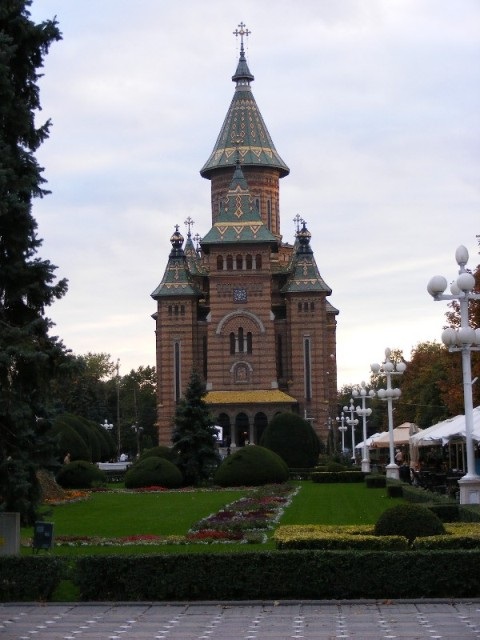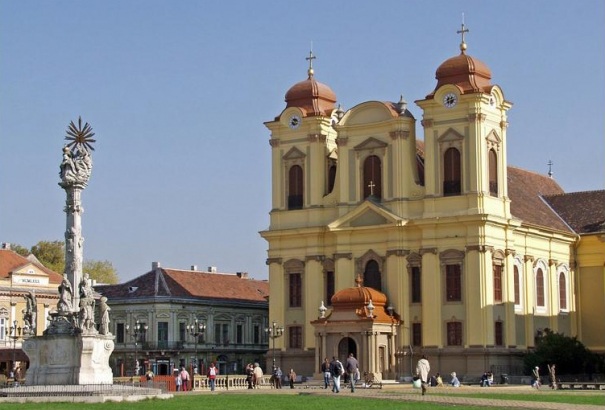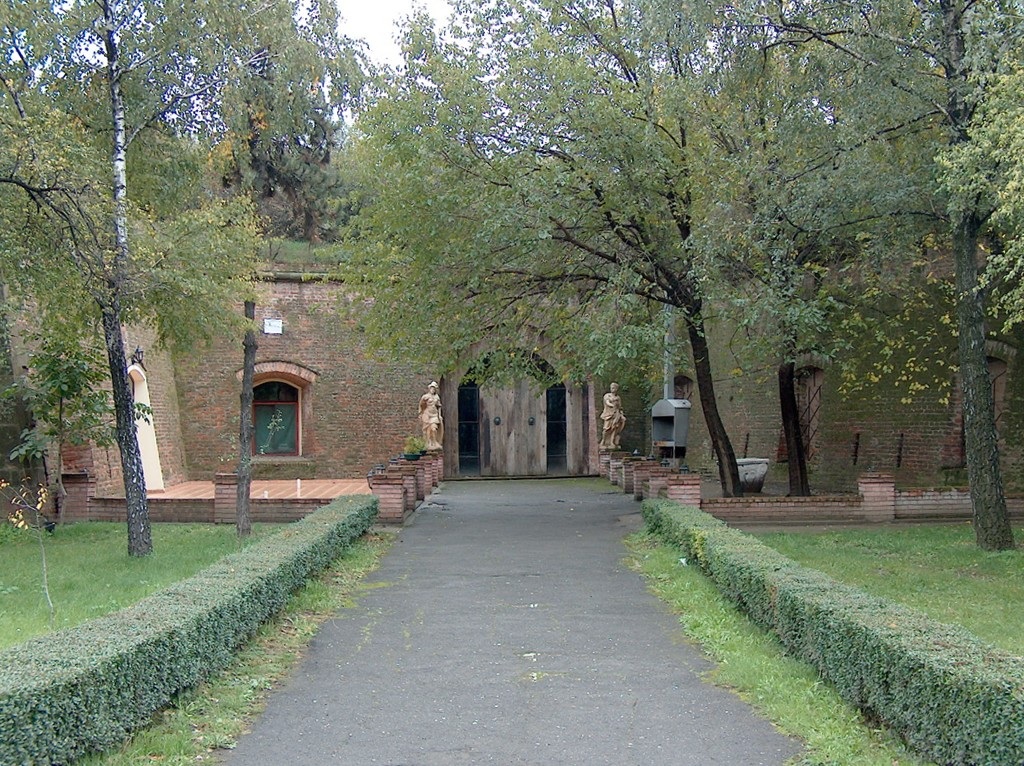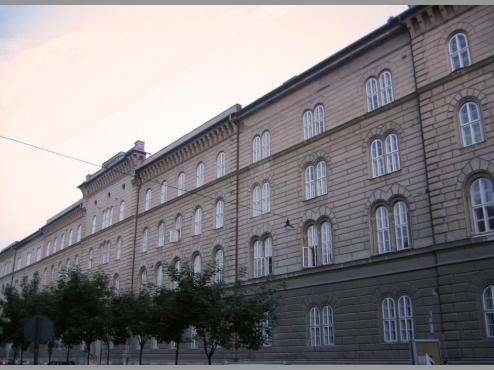ABOUT TIMISOARA
Timişoara (German: Temeschburg, also Temeswar or Temeschwar, Hungarian: Temesvár, Serbian: Темишвар, Temišvar, Turkish: Temeşvar), is a city in the Banat region of western Romania. It is the capital of Timiş County.
Nickname: Little Vienna.
Country Romania
County Timiş County
Status County Capital
Area - City 129.2 km2 (49.9 sq mi) - Metro 1,070.4 km2 (413.3 sq mi)
Elevation 89 m (292 ft)
Population (est. 2009) - City 312,113 -
Density 2,415.7/km2 (6,256.7/sq mi) -
Metro 359,132
Time zone EET (UTC+2) - Summer (DST) EEST (UTC+3)
History
Timişoara was first mentioned as a place in either 1212 or 1266. The territory later to be known as Banat was conquered and annexed by the Kingdom of Hungary in 1030. Timişoara grew considerably during the reign of Charles I, who, upon his visit here in 1307, ordered the construction of a royal palace. Timişoara's importance also grew thanks to its strategic location, which facilitated control over the Banat plain. John Hunyadi established a permanent military encampment here, and moved here together with his family. In 1552, Ahmed Pasha conquered the city with a 16,000 Ottomans and transformed it into a capital city in the region. The local military commander, Stefan Losonczy, was captured and beheaded on July 27, 1552 after resisting the Ottoman invasion with just over 2,300 men.
Timişoara remained under Ottoman rule for nearly 160 years, controlled directly by the Sultan and enjoying a special status, similar to other cities in the region such as Budapest and Belgrade. During this period, Timişoara underwent a process of Islamization, until Prince Eugene of Savoy conquered it in 1716. Subsequently, the city came under Austrian rule, and it remained so until the early 20th century except Ottoman occupation between 1788-1789 during Ottoman-Habsburg war. During this time, Timişoara evolved from a strategic fortress to an economic and industrial center: numerous factories were built, electric illumination and public transport were introduced, and railroad connections were established. The city was defortified, and several major road arteries were built to connect the suburbs with the city center, paving the way for further expansion of the city limits
It was the first mainland European city to be lit by electric street lamps in 1884. It was also the second European and the first city in what is now Romania with horse drawn trams in 1867. Gustave Eiffel, the creator of the Eiffel Tower in Paris, built one of Timişoara's footbridges over the Bega.
On October 31, 1918, local military and political elites establish the "Banat National Council", together with representatives of the region's main ethnic groups: Hungarians, Romanians, Serbs and Germans. In the aftermath of World War I, the Banat region was divided between the Kingdom of Romania and the Kingdom of Serbs, Croats and Slovenes, and Timişoara came under Romanian administration after Serbian occupation between 1918-1919. In 1920, King Ferdinand I awarded Timişoara the status of a University Center, and the interwar years saw continuous economic and cultural development. A number of anti-fascist and anti-revisionist demonstrations also took place during this time.
During World War II, Timişoara suffered damage from both Allied and Axis bombing raids, especially during the second half of 1944. On August 23, 1944, Romania, which until then was a member of the Axis, declared war on Nazi Germany and joined the Allies. Surprised, the local Wehrmacht garrison surrendered without a fight, and German and Hungarian troops attempted to take the city by force throughout September, without success.
After the war, the People's Republic of Romania was proclaimed, and Timişoara underwent sovietization and later, systematization. The city's population tripled between 1948 and 1992. In December 1989, Timişoara witnessed a series of mass street protests by Romanians, Hungarians and Serbs, in what was to become the Romanian Revolution of 1989.
Culture
The city center largely consists of buildings from the Austro-Hungarian era. The old city consists of several historic areas. These are: Cetate (Belváros in Hungarian, Innere Stadt in German), Iosefin (Józsefváros, Josephstadt), Elisabetin (Erzsébetváros, Elisabethstadt), Fabric (Gyárváros, Fabrikstadt). Numerous bars, clubs and restaurants have opened in the old Baroque square (Unirii Square).
Timisoara Orthodox Cathedral
The Timişoara Orthodox Cathedral (Catedrala Ortodoxă) is a Romanian Orthodox cathedral in Timişoara, Romania. It was built between 1937 and 1940. It is dedicated to the Three Holy Hierarchs, Saints Basil the Great, Gregory the Theologian, and John Chrysostom. It has 11 towers, of which the central and the highest has a height of 96 meters.
It is home to many valuable religious objects such as old icons and early writings in Romanian, such as the 1648 Noul Testament de la Bălgrad ("The New Testament of Bălgrad") and the 1643 Cazania lui Varlaam ("The Homiliary of Metropolitan Varlaam").
The building's style is quite unusual among Romanian Orthodox buildings, although it is partly based on local religious tradition and partly on Byzantine architecture (the style developed by Moldavian and Byzantine artisans had transplanted and adapted). Elements such as niches under the eaves, starry vaulting in the interior, and lacquered discs in a variety of colors, can be seen in monasteries such as Cozia or Prislop (both built in the 14th century and based on guidelines devised by the monk Nicodim of Prilep).
The church's interior and exterior paintings were created by the painter Atanasie Demian. The difficult period that followed the structure's completion prevented the paintings from being finished on time, so this work went on for many years after World War II.
St. George's Cathedral
The St. George's Cathedral, Timişoara. or The Dome is located in Timişoara, Romania, at Piaţa Unirii, in the centre of town.
The cathedral's foundation stone was put on 6th of August 1736. It was designed by Joseph Emanuel Fischer von Erlach from Vienna, then Hans Lechner continued the building from 1750. It was finished by two architects from Timişoara, Johann Theodor Kostka and Carl Alexander Steinlein in 1774. The Dome was built in Austrian baroque style and it was dedicated to Saint George, the dioceses patron saint. The picture located at the high altar was painted by Michel Angelo Unterberger, the director of fine arts academy of Vienna, illustrating the patron saint. The side altars were painted by Johann Nepomuk Schöpf in 1772. The precious oil-lamps were made by Josef Moser. The organ was made by Leopold Wegenstein, and it provides an impressive experience for the ears. The cathedrals bells were renewed in Germany in 1998.
Millennium Church
The Millennium Church is located in the Fabric quarter of Timişoara, Romania, near the main Traian square.
The church was built in the Neo-Romanesque style by Lajos Ybl, the foundation-stone being placed in 1896. It was sanctified on 13th of October 1901 by Sándor Dessewffy.
The main towers are 65m high, the central cupola 45m, and the capacity is for 3,000 people. The bell was made by Antal Novotny. The altar-piece was painted by György Vastagh and its organ was made by Leopold Wegenstein.
Huniade Castle
The Huniade Castle (Castelul Huniade in Romanian) is the oldest monument of Timişoara, built between 1443 and 1447 by John Hunyadi over the old royal castle dating from the 14th century (built during the reign of Charles of Anjou). It currently houses the History Section and the Natural Sciencies Section of the Banat Museum.
Maria Therezia Bastion
The Maria Therezia Bastion was built between the years of 1730 and 1735 and is the largest remaining part of what was once the old citadel of Timisoara. Today, it is used as a passage but also hosts shops, restaurants, bars, a discotheque, a bookstore as well as two permanent exhibitions of the Banat Museum: Informational and Communications technology and ‘The Violin’ – passion of a lifetime. The ethnographic section of the Village Museum can also be found here.
The Maria Therezia Bastion is the largest part of the old defense walls of the old citadel of Timisoara that has remained until today. There are two other fragments remaining from the former walls, one in the Botanical Garden and one on Al. Ioan Cuza Way.
All the other bastions have been destroyed to make way for the new buildings. After Timisoara was conquered by the Hapsburgs in 1716, it was clear that the fortifications could no longer face the new war technologies so the decision was made to rebuild the whole citadel in Vauban style (a star-shaped bastion-fortress). The building covered a ten-times larger surface than the old medieval Turkish fortress. It was surrounded by three star-shaped moats. The access was made through three gates: Vienna, Petrovaradin and Ardeal (all demolished in 1891). The nine bastions of the citadel bore the names emperors, empresses and generals.
The National Romanian Opera of Timisoara
The Romanian National Opera of Timisoara is a national company for opera, operetta and ballet, being a public institution operating as a legal entity under the Romanian Ministry of Culture.
The Romanian Natonal Opera of Timisora was established through the Royal Decree No. 254 of March 30th, 1946. The firs Director was Aca de Barbu.
Short history.
Timisora was and still is the most powerful cultural center of Western Romania. The favorable geographic location, at the crossroads between Central and Eastern Europe gives Timisoara a cultural opening. Situated at less than 700 kilometers distance from 13 European capital cities, it benefited along time of a continuous link to European cultural values. The population of this multi-ethnical and multi-cultural space that belongs to different ethnics and religious beliefs, makes Timisoara a model of European civilization.
The construction of the Palace of Culture started in 1871, in the vision of two Viennese architects Helmer and Fellner (creators of many European theatre halls including ones in Budapest, Vienna, Odessa) and was completed in 1875. Two great fires affected the building. The first was in 1880, the reconstruction works going on until 1882, when the original, renaissance form of the building was kept. The second was in 1920, intact remaining only the wings. Architect Duiliu Marcu undertook the works keeping only the wing facades in their original style giving the neo-byzantine style – typical for Romanian architecture of the time – to the main façade and the theatre.
Dicasterial Palace
The Dicasterial Palace, the building which today hosts the Courts of Timisoara, Timis and the Court of Appeal, was built between the years of 1855-1860, being initially intended to be the home of the Banat Governor.
A monumental construction, built on a surface that extends along three streets, this edifice was for a long time the largest building in Timisoara. The palace, build on three stories, had in the beginning 273 offices, 34 servant`s rooms, 34 kitchens, 65 cellars, 27 warehouses, all these being groupd around three interior patios. It was built in Italian Renaissance style, imitating the Medici Palace in Florence.
The facades are structured in horizontal registers, the rhythm being given by the windows. The ornaments of the windows are reduced to small colonnades that flank the windows of the first floor. This building breaks the urban pattern with its proportional modification of the ambient. with Imposing by dimension, singularity and signification the palace expresses its function for which it has been created. Its massive and over-dimensioned volume annuls the scale of neighborhoods from which there is ensured just a partial perception of the monumental.
Palatul Lloyd
is a historical building that stands in Victoria Place in Timisoara.It was built between the years of 1910-1912 according to the plans of the architect Leopold Baumhorn. The architecture is eclectic with secessionist influences.
Performing arts
• Banatul Philharmonic of Timişoara (Filarmonica Banatul Timoșoara);
• Romanian Opera House (Opera Romana Timişoara);
• National Theatre (Teatrul Naţional);
• German State Theatre (Teatrul German de Stat);
• Hungarian State Theatre (Teatrul Maghiar de Stat);
• Puppet Theatre (Teatrul pentru copii si tineret "Merlin");
• Festivalul Plai, a world music and jazz festival;
Natives
• Iolanda Balaş: former athlete, 2 times Olympic champion in the women's high jump, considered one of the greatest high jumpers ever;
• Mircea Baniciu: musician who is playing with the famous bands Transsylvania Phoenix and Pasărea Colibri;
• Ana Blandiana: poet, essayist, and political figure;
• Horia Colibăşanu: the first Romanian mountain climber to reach the summit of K2, Manaslu, Dhaulagiri and Annapurna;
• Cosmin Contra: footballer, voted 2 times in 1999 and 2001 the best right defender in the UEFA Team of the Year;
• Mircea Baniciu: music composer, best known as the leader of Rock band Phoenix, for which he is vocalist and guitar player, with more than 40 years of activity;
• Hanno Höfer: German-Romanian movie director, producer and musician;
• Ioan Holender: Romanian-born Austrian director of Vienna State Opera;
• Hugo Jan Huss: orchestra conductor and music director;
• Ion Ivanovici: military band leader and composer, best remembered today for his waltz Waves of the Danube;
• George Lusztig: Romanian American mathematician and Abdun Nur Professor at the Massachusetts Institute of Technology (MIT), also a Norbert Wiener Professor with the Department of Mathematics from 1999 to 2009;
• Dan Nicolae Potra: retired artistic gymnast who was Romania's first male gymnast to win the European all around title (2002);
• Johnny Weissmuller: Romanian born American swimmer and actor of German descent, famous for winning 5 Olympic gold medals for the United States and for portraying Tarzan in films;
• Herta Muller (1953) writer, in 2009 NOBEL prize winner for literature;
















